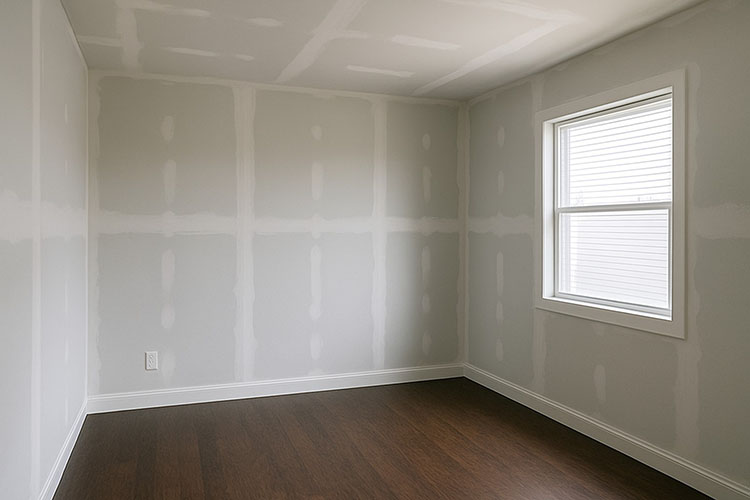Painting fresh drywall might seem simple—just roll on your favorite color and call it a day. However, skipping primer almost always leads to blotchy walls, wasted paint, and a finish that won’t last. This article covers why primer is so important for new drywall, how it works, and how to pick the right one.
Why New Drywall Soaks Up Paint
Drywall (sometimes called wallboard) consists of a soft, absorbent core wrapped in paper. When it’s first installed, the seams and screw holes are covered with joint compound (that white “mud” you see) and tape, then sanded smooth. Even after the compound dries, the underlying board still soaks up water and paint unevenly. If primer is skipped and finish paint is applied directly, lighter and darker patches will likely appear where the drywall absorbed different amounts of paint. Hiding those patches often requires two or three coats of paint instead of one—spending more time and money than necessary. A single coat of primer seals the surface so that paint goes on evenly.

How Primer Prepares Your Walls
Primer is a special coating that soaks into drywall and creates a uniform base. Here’s how it helps:
- Seals the Surface Primer fills tiny pores in both the paper facing and the core, making the wall less absorbent. This means finish paint stays on the surface instead of disappearing into the drywall fibers.
- Creates a Consistent Look New drywall and joint compound can reflect light differently. Primer gives everything a uniform appearance so that, once the finish paint dries, there won’t be visible stripes or blotches.
- Helps Paint Adhere Paint adheres more reliably to primer than to bare drywall. That extra grip helps prevent peeling, chipping, or flaking as time goes on.
- Prevents Minor Stains Occasionally, joint compound or tape can leave faint marks that bleed through finish paint. Primer locks these in place so they do not reappear later.
Most primers are dry to the touch within an hour and can be painted over in two to four hours, depending on humidity and temperature. Always follow the drying-time instructions on the label.
Why Skipping Primer Costs More in the Long Run
Applying finish paint directly to unprimed drywall may seem faster, but it typically results in: - Uneven Color and Sheen Without primer, drywall and joint compound absorb paint at different rates, producing blotches or stripes. Even with two or three coats, faint variations often remain. Primer seals everything first, so the finish coat goes on smoothly and appears uniform.
- Higher Paint Usage New drywall acts like a sponge, requiring two or three finish coats just to hide the surface. With primer in place, one coat of finish paint often suffices—saving money and reducing waste.
- Reduced Durability Paint that cannot bond properly to drywall will likely peel or chip sooner. Primer provides the proper surface for the paint to adhere to, extending the life of the finish.
- Extra Time and Effort Skipping primer might save a few minutes initially, but you end up spending more time applying additional finish coats and handling touch-ups. A single coat of primer requires about an hour to apply and a few hours to dry, but it cuts down on how many finish coats are needed and reduces the chance of rework.
In most situations, purchasing primer costs far less than the extra paint and labor involved when primer is omitted.
The Bottom Line
Drywall will absorb paint unevenly unless it is sealed first. Primer ensures paint goes on evenly, uses less paint, and produces a finish that lasts. Although it adds one extra step, primer is essential for achieving a professional, durable result. Before painting new drywall, allow time for a coat of primer—your walls will look smoother, the color will stay true, and the finish will hold up for years.
